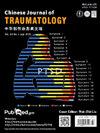不可复位、矢状不稳定转子周围骨折的微创复位:新技术和早期结果。
IF 1.9
4区 医学
Q2 ORTHOPEDICS
引用次数: 0
摘要
目的:由于传统技术无法实现闭合复位,因此无法复位、矢状面不稳定的转子周围骨折的治疗面临重大挑战。本研究介绍一种新颖的微创技术,利用长角度止血钳的机械优势原理。方法:对16例经皮止血钳杠杆复位术治疗的矢状不稳定转子周围骨折患者进行回顾性分析。纳入标准:(1)术前确认骨折类型为转子周围骨折;(2)术中影像学证实骨折部位矢状面移位;(3)年龄:18岁。排除标准:(1)开放性骨折、病理性骨折、糖尿病患者;(2)长期使用皮质类固醇;(3)局部皮肤或全身状况不适合手术的患者。定期随访,间隔6 - 8周,直到在x线评估中有明显的骨巩固证据。对对齐质量的评估考虑了诸如颈轴角的重建、所有皮质骨边缘的完整性以及任何平移位移的矫正等因素,同时使用Harris评分系统对髋关节功能进行评估。采用SPSS 25.0软件对相关数据进行统计分析。结果:16例患者平均年龄56.8岁(25 ~ 81岁),男8例,女8例。根据AO/OTA骨折分类,该队列包括31A型13例,32A型2例,32C型1例。从入院到手术当天的时间为3 ~ 11天,平均5.1天。所有10例病例均成功实施闭合复位,无需过渡到开放式复位。平均手术时间为105.8 min (80 ~ 180 min)。通过与正常侧的对比,确定了满意的还原质量。Harris髋关节评分平均为94.1(范围87 ~ 99),骨折愈合时间4.2个月(3 ~ 6个月)。未见种植体失败和畸形愈合。结论:本研究为降低矢状面不稳定、不可复位的转子周围骨折提供了一种替代的微创技术。该技术具有治疗复杂骨折的潜力,其疗效与通常用于简单且易于复位的骨折相同。本文章由计算机程序翻译,如有差异,请以英文原文为准。
Minimally invasive reduction of irreducible, sagittally unstable peritrochanteric fractures: Novel technique and early results
Purpose
The management of irreducible, sagittally unstable peritrochanteric fractures presents a significant challenge due to the inability to achieve closed reduction using conventional techniques. This study introduces a novel minimally invasive technique leveraging the mechanical advantage principle with long, angled hemostatic clamps.
Methods
A retrospective review was performed on 16 patients who sustained sagittally unstable peritrochanteric fractures and underwent a percutaneous hemostatic clamp leverage reduction procedure. Inclusion criteria: (1) Preoperative confirmation of fracture type as peritrochanteric fracture; (2) Intraoperative imaging confirms the presence of sagittal plane displacement at the fracture site; (3) Age > 18 years. Exclusion criteria: (1) Open fractures, pathological fractures, and diabetes; (2) Long-term use of corticosteroids; (3) Patients with local skin or systemic conditions not suitable for surgery. Regular follow-ups at intervals of 6 – 8 weeks continued until evidence of bone consolidation was apparent in radiographic assessments. Evaluation of the alignment quality considered factors such as the re-establishment of the neck-shaft angle, the integrity of all cortical bone edges, and the rectification of any translational displacement, while the assessment of hip functionality was performed using the Harris scoring system. Statistical analysis of the relevant data was performed using SPSS 25.0 software.
Results
The average age of these 16 patients was 56.8 years (ranging from 25 to 81 years), consisting of 8 males and 8 females. According to the AO/OTA fracture classification, the cohort included 13 cases of type 31A, 2 cases of type 32A, and 1 case of type 32C. The time from hospital admission to the day of surgery ranged from 3 to 11 days, with an average of 5.1 days. Closed reduction was successfully implemented in all 10 instances, negating the necessity for transition to open reduction procedures. The mean operative duration was 105.8 min (range 80 – 180 min). Satisfactory results of the quality of reduction were determined by comparison with the normal side. The average Harris hip score was 94.1 (range 87 – 99), and the fracture healing time was 4.2 months (3 – 6 months). Implant failure and malunion were not observed.
Conclusions
This study provides an alternative, minimally invasive technique for reducing sagittally unstable, irreducible peritrochanteric fractures. This technique holds the potential to manage complex fractures with the same efficacy as is typically reserved for simple and easily reducible fractures.
求助全文
通过发布文献求助,成功后即可免费获取论文全文。
去求助
来源期刊

Chinese Journal of Traumatology
ORTHOPEDICS-
CiteScore
3.80
自引率
4.80%
发文量
1707
审稿时长
28 weeks
期刊介绍:
Chinese Journal of Traumatology (CJT, ISSN 1008-1275) was launched in 1998 and is a peer-reviewed English journal authorized by Chinese Association of Trauma, Chinese Medical Association. It is multidisciplinary and designed to provide the most current and relevant information for both the clinical and basic research in the field of traumatic medicine. CJT primarily publishes expert forums, original papers, case reports and so on. Topics cover trauma system and management, surgical procedures, acute care, rehabilitation, post-traumatic complications, translational medicine, traffic medicine and other related areas. The journal especially emphasizes clinical application, technique, surgical video, guideline, recommendations for more effective surgical approaches.
 求助内容:
求助内容: 应助结果提醒方式:
应助结果提醒方式:


